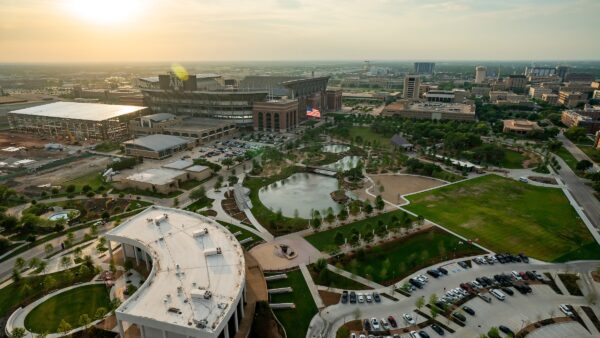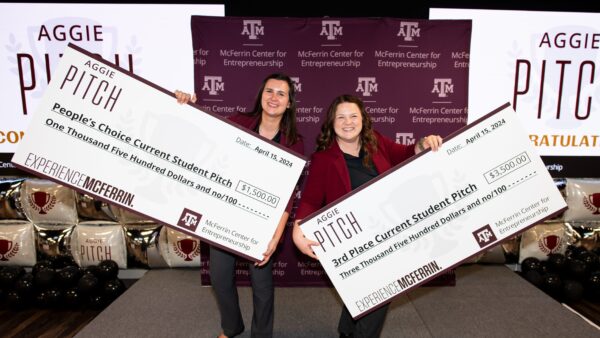Sweat And Science: How A Team Of Pros Gets Kyle Field Ready For Game Day
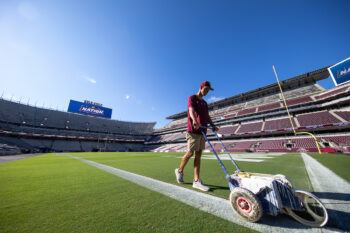
When most people watch a football game at Kyle Field, they’re keeping their eyes on the ball. Nick McKenna is watching the players’ feet.
“For us, we’re always watching the footwork,” said McKenna, assistant athletics director of sports fields for Texas A&M Athletics. “I’m watching how their foot interacts with the surface; Is the running back able to make a hard cut? When our quarterback drops back and plants his foot to make a snap decision, is the turf holding up?”
An industry veteran in charge of Texas A&M’s entire contingent of sports fields, McKenna leads a dedicated group of students and professionals operating by a single motto: “If we do our job right, you’ll never even know we were there.”
It may sound like thankless work, but for McKenna and his team, it’s often a point of pride — especially when it comes to Aggieland’s first and most famous sports venue. During a typical Aggie football game, Kyle Field will be seen by upwards of 100,000 spectators, plus millions more tuning in on TV, as teams clash against the perfectly green backdrop. To the untrained eye, it can sometimes seem too perfect.
“I think I feel the most proud when somebody comes up to me and says, ‘That’s an artificial field, right?’” says sports fields coordinator Drew Selensky, a Class of 2020 graduate who oversees the historic field’s day-to-day care and maintenance.
As the proud third-generation Aggie will tell you, the playing surface at Kyle is 100 percent real — roughly 74,000 square feet of living, breathing Bermuda grass, carefully cultivated to handle the heaviest tackles, tightest pivots and strongest sprints.
“We have some of the best athletes in college football play here,” Selensky said. “I want them to be able to play on the most safe and consistent surface possible.”
For McKenna, Selensky and the rest of the Texas A&M field crew, game days are typically the easiest part of the job — a chance to sit back and watch their efforts pay off. The real work comes in the grueling hours, days and weeks leading up to kickoff.
“We mow seven times a week,” Selensky said. “We’re constantly throwing fertilizers out. When game week rolls around, we’re out here with painters. I do my best to plan for the future, what we’re going to do next week or a month from now, but a lot of what I do is also dictated by mother nature.”
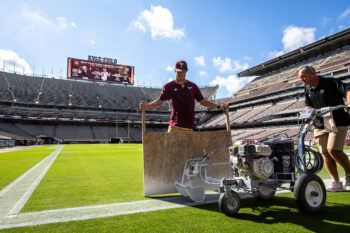
Strong Roots
Like many Aggies, Selensky’s history with Kyle Field runs deep. A Baytown native, he grew up rooting for the Maroon and White alongside his parents, siblings and other relatives.
“To everybody in my family, it’s kind of the coolest thing in the world,” he said. “This is the cornerstone of Texas A&M, it’s the fourth-largest stadium in the country. This field means so much to me because there’s just so much history here.”
Selensky started working on the field while he was still a student in the College of Agriculture and Life Sciences’ turfgrass science major, one of the top programs of its kind in the nation.
Dr. Chase Straw, an assistant professor and turfgrass scientist in the Department of Soil and Crop Sciences, says the best way to learn turfgrass management is by actually doing it, and a close partnership with Texas A&M Athletics allows students to do just that.
“A good portion of the students in our program are geared toward sports field management, so it’s nice to be able to send students over there to gain hands-on experience working on Kyle Field, Olsen Field and all the other fields on campus,” Straw said.
For Selensky, that opportunity was the first step on an exciting new career path, allowing him to flex the knowledge and techniques he picked up from his professors in a challenging, hands-on setting.
“My dad and my mom were kind of skeptical about me getting a job while in the middle of changing majors — I kind of had to sell it to them,” he said. “I said this a really good opportunity to be able to directly apply what I’m learning in class.
“Being able to learn the foundations and the science of what we’re doing, and then take what would be a perfect scenario in a lab and have to adjust that for a real-world situation — that’s something I will cherish forever.”
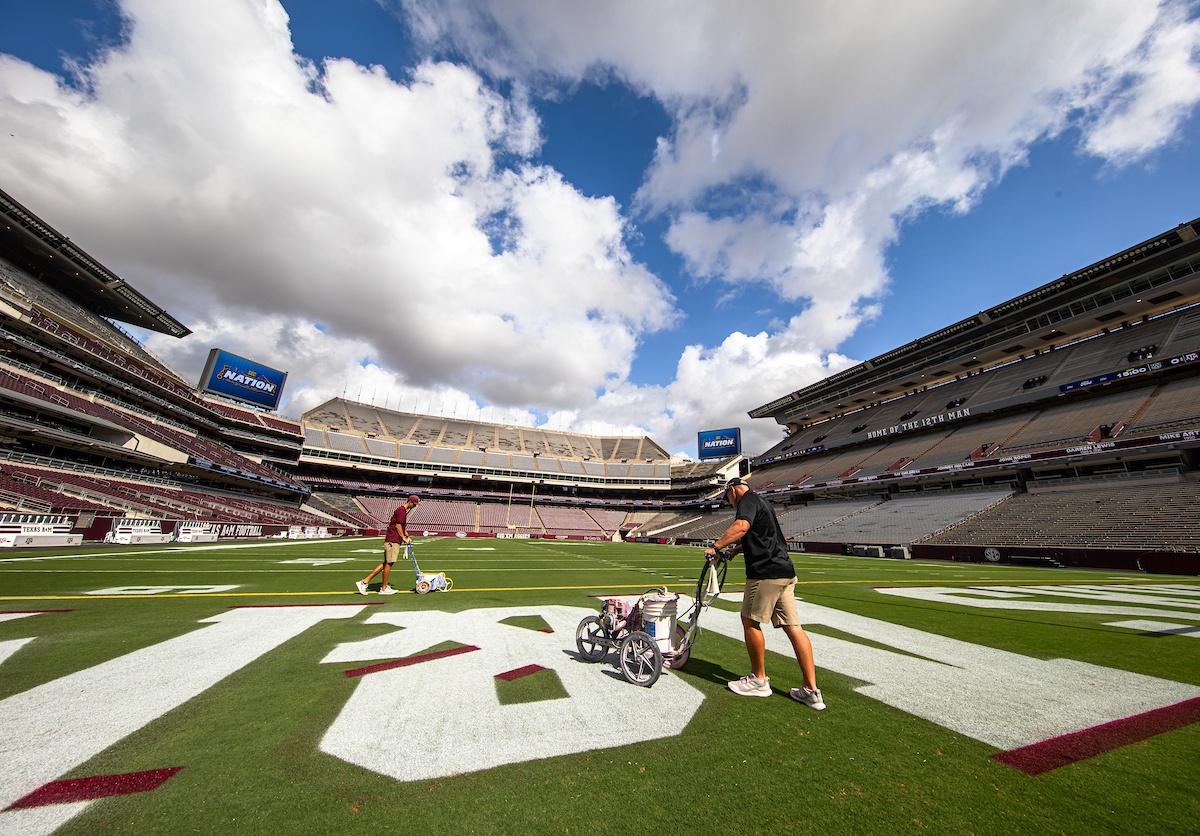
“I think I feel the most proud when somebody comes up to me and says, ‘That’s an artificial field, right?’”
Cultivating Success
The sheer amount of science and math involved in managing a playing surface — especially one as high-profile as Kyle Field — can often go overlooked, McKenna said. That’s another area where the partnership with the Turfgrass Science program comes in handy.
“I tell people I don’t just have to be an expert in grass, I have to be an expert in 30-some different scientific categories, whether it’s soil physics, soil chemistry, plant biology, plant physiology, meteorology, chemistry, the list goes on and on,” McKenna said.
Thanks to Straw and other researchers, McKenna and Selensky have access to cutting-edge research and scientific tools that help them perfect every aspect of A&M’s playing fields, tailoring each surface to the athletes’ needs.
“From a research standpoint, we are very fortunate to have field managers like we have at Texas A&M because they allow me to pitch ideas to them and test devices that quantify different surface characteristics, like soil moisture and surface hardness,” Straw said. One such tool allows the team to measure the shear strength of the grass, showing how much force an athlete can apply before the turfgrass rips apart.
As McKenna explains, rips and divots actually function as a unique safety feature of natural grass fields, taking stress off of the athlete’s body and potentially reducing the risk of injury.
“We want the grass to divot because a lot of times it saves an athlete’s ankle or their knee,” he said. “Once it gets to a certain workload, we want the grass to give way before the player’s ACL gives way.”
Another potential advantage of natural grass over artificial turf is how it holds temperature, Straw said. As a living organism, grass is much more effective at absorbing and dissipating heat, which can make a big difference under the relentless Texas sun.
“When we have a summer like we did in Texas this year, we can have anywhere from an 80-90 degree Fahrenheit surface temperature difference between grass and artificial turf,” Straw said.
At the same time, Texas’ brutal heat and unpredictable rainfall can make it more difficult to keep a natural grass field hydrated and healthy. Selensky has to continuously adjust irrigation schedules to account for these environmental factors: “We want to water as little as possible, but also maximize performance,” he said.
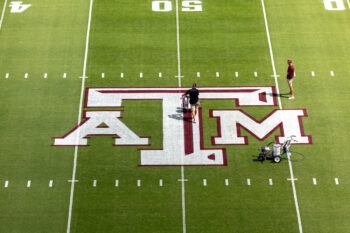
Sowing New Seeds
While the team still conducts most of their work outside the public eye, Selensky has recently started lifting the curtain a bit, finding success on TikTok with videos of the crew mowing, watering and re-seeding the field between games. One recent post shows a slow-motion view of an aerifier, a specialized tool that pokes holes in the ground to alleviate soil compaction.
“I just kind of made them, I didn’t really expect to get any traction on them,” he said. “But being able to see comments like ‘hey, we really appreciate what you do’ or ‘whoa, I didn’t know that’s what it took to do that,’ it’s been very cool and very humbling.”
Selensky says the videos have quickly become a favorite of the Baytown Aggie Moms Club, and have also led to a handful messages from aspiring turfgrass students interested in attending A&M. He hopes all the online attention will help grow the industry as a whole — especially as the turfgrass program in Aggieland looks to bring in more students and place them at the highest levels of the workforce.
“In the last three years, we’ve had students graduate and go on to several high-end golf courses, we have Drew at Kyle Field, we have another student at the Boston Red Sox, and we have one at the Austin FC Major League Soccer stadium,” Straw said. “There’s a lot of opportunities for our students, and it’s really exciting to see where they go.”
Turfgrass science students in Texas A&M’s Turfgrass Management Club are currently conducting their fall fundraiser. To learn how you can support the turfgrass program while adding a splash of Aggie color to your home’s lawn, visit the club’s online store page.
Media contact: tamunews@tamu.edu


